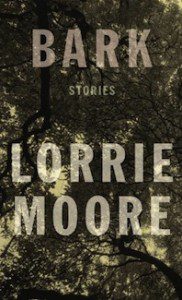
I’m tempted to say that Lorrie Moore is a master of the feel-bad story. You don’t turn to her for depictions of love that endures despite hardships or for the triumph of the individual in the face of evil. But that wouldn’t be quite right, because her stories make me feel good, and I suspect the same is true for others. Why is this? Of course it is partly Moore’s sheer verbal dexterity and her rightly-celebrated sense of humor. But more important, to my mind, is a certain bracing quality in her writing. One has the sense of receiving truths that are disagreeable but that, once set plainly in black and white, have a little less power over us.
But the accuracy of what I’m calling these “bracing truths” is never certain. Few things are in Lorrie Moore’s world. In her new collection, Bark, (which is wonderful, by the way, so if you’re reading this review to try to decide whether or not you should read it, the answer is yes, you should), a character reflects that “life was long and not that edifying, and one sometimes had to make do with randomly seized tidbits.” The characters in these stories often build their lives on speculation, on things one read somewhere (that thing about a frog acclimating to boiling water if you raise the temperature slowly enough gets mentioned twice), and sometimes on theories that don’t quite hold up in practice. Moore’s characters are usually lonely, and loneliness can breed a certain sort of unreliability, the associative loopiness of a person who’s gone too long without meeting one of their basic needs, like sleep or food or human interaction. (Rejecting the bromide that single people need to “learn to be alone,” one character notes that “If you had forgotten, it would quickly come back to you. Aloneness was like riding a bike. At gunpoint. With the gun in your own hand.”)
The question that plagues these characters is often what to do with their bleak visions, especially as they pertain to romantic attachments. They are like the man in the Woody Allen joke who thinks he’s a chicken but doesn’t want to be cured of his delusion because he “needs the eggs.” “[I]f one knew the future,” one of Moore’s character thinks,
all the unexpected glimpses of the beloved, one might have trouble finding the courage to go on. This was probably the reason nine-tenths of the human brain had been rendered useless: to make you stupidly intrepid. One was working with only the animal brain, the Pringle brain.

The protagonist of the collection’s first story, “Debarking,” who is dating, or trying to date, a single mother who is unusually physically and emotionally intimate with her teenage son, thinks of “all the deeply wrong erotic attachments made in wartime, all the crazy romances cooked up quickly by the species to offset death.”
This could be a tagline for the entire collection, at least as far as romantic attachments go. They are never ideal, always matters of making do with what’s available. The protagonist of the story’s longest (and possibly strongest) story, “Wings,” who, like many of Moore’s characters, is involved with someone who does not seem to have anything close to her best interests at heart, thinks,
Romantic hope: From where did women get it? Certainly not from men, who were walking caveat emptors. No, women got it from other women, because in the end women would rather be rid of one another than have to endure themselves on a daily basis. So they urged each other into relationships. “He loves you! You can see it in his eyes!” they lied.
In another story, Moore gives a nod to “those experimental monkeys with the wire-monkey moms.” This is what most of Bark’s characters’ relationships amount to. In “Paper Losses,” a middle-aged couple is described as “currently… partners only in anger and dislike”; hate is “their newly successful project together,” in which they are “complicitous and synergistic… In tandem, as a system, as a dance team of bad feeling, they had shoved their hate center stage and shone a spotlight down for it to seize.”
There’s something pleasingly uneven about both individual stories in Bark and the collection as a whole. There are plenty of stories being written today that are exquisitely structured, attentive to what writers sometimes like to call “the rigors of the form.” Moore’s stories are, to my mind, a reprieve from this vision of short story as difficult geometrical equation. Instead, they offer the pleasure of immersing oneself in a distinctive sensibility, a voice that cannot fully accommodate itself to the world but hasn’t given up trying to make do with the materials at hand.




